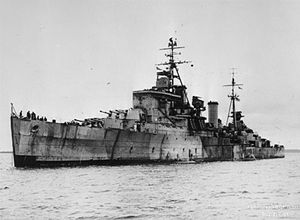
Back Леки крайцери тип „Минотавър“ Bulgarian Třída Minotaur (1943) Czech Clase Minotaur (1943) Spanish ناو کلاس مینوتر (۱۹۴۳) FA Minotaur-luokka (risteilijä, 1943) Finnish Classe Minotaur (1943) French Classe Minotaur (incrociatore 1943) Italian スウィフトシュア級軽巡洋艦 Japanese Лёгкие крейсера типа «Свифтшур» Russian Minotaur-klass (1943) Swedish
This article includes a list of general references, but it lacks sufficient corresponding inline citations. (January 2013) |

| |
| Class overview | |
|---|---|
| Name | Minotaur class |
| Operators | |
| Preceded by | Fiji class |
| Succeeded by | Neptune class (planned) Tiger class (actual) |
| Built | 1941–1945 |
| In commission | 1944–1958 |
| Planned | 9 |
| Completed | 3 |
| Cancelled | 6 |
| Scrapped | 3 (3 other early-stage Minotaur hulls became the Tiger class) |
| General characteristics | |
| Type | Light cruiser |
| Displacement |
|
| Length | 555.5 ft (169.3 m) |
| Beam | 63 ft (19 m) (Superb: 64 ft (20 m)) |
| Draught | 17.25 ft (5.26 m) |
| Installed power | 72,500 shp (54.1 MW) |
| Propulsion |
|
| Speed | 31.5 knots (58.3 km/h) |
| Range |
|
| Complement | 867 |
| Armament |
|
| Armour | |
The Minotaur class, also known as the Swiftsure class after the lead ship was sold to Canada and renamed, were a group of light cruisers of the British Royal Navy built during the Second World War. They were designed as a modified version of the Fiji class incorporating war modifications and authorised in 1941. However, in spite of the heavy toll of cruisers in that year and the following one, the building of this new class had a relatively low priority and only three of the planned twelve were completed by end of World War II. They played no significant part in the Second World War, though Swiftsure, as flagship of the British Pacific Cruiser Squadron, was selected by Admiral Cecil Harcourt to hoist his flag for the Japanese surrender at Hong Kong.
Superb was completed to a slightly different design than the first two ships, work on another three was cancelled and the last three were eventually built to a different design as the Tiger class.